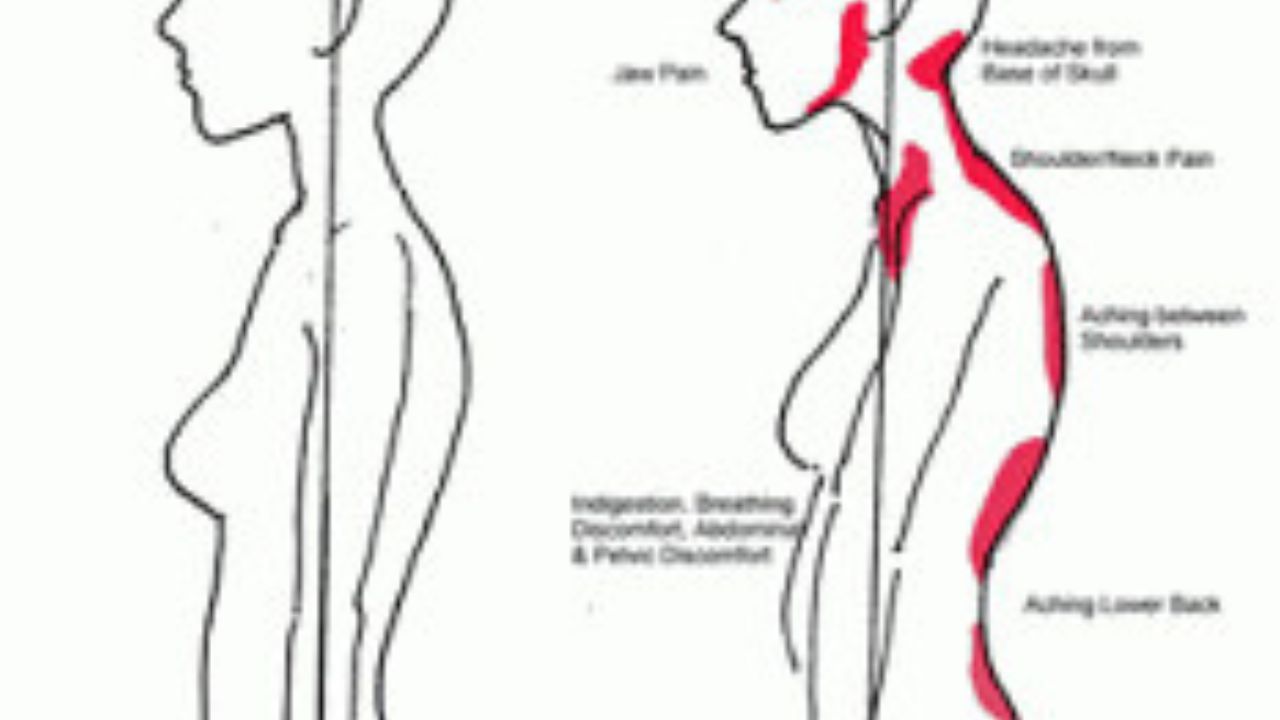
In today's sedentary lifestyle, maintaining good posture is crucial for overall health and well-being.
This article explores the top 10 strategies for correcting poor posture and achieving a healthier you.
From identifying bad habits to incorporating stretching exercises and ergonomic tips, we provide practical guidance to help you improve your posture throughout the day.
Whether you're an office worker, a fitness enthusiast, or a parent concerned about your child's posture, this article offers valuable insights to help you straighten up and live a more balanced life.
The Importance of Good Posture
In today's sedentary lifestyle, maintaining good posture is more important than ever for overall health and well-being. Proper posture plays a crucial role in daily activities, as it not only enhances physical appearance but also ensures optimal functioning of the body.
Whether sitting at a desk, standing, or even walking, maintaining correct alignment of the spine and proper positioning of the limbs is essential to prevent musculoskeletal issues and promote efficient movement. For older adults, posture correction techniques become even more significant as they are prone to age-related changes in the musculoskeletal system.
Engaging in exercises that strengthen the core muscles, practicing proper body alignment, and using ergonomic supports are effective ways to correct and maintain good posture. By incorporating these techniques into daily routines, individuals can improve their overall posture, prevent discomfort, and enhance their quality of life.

Identifying Poor Posture Habits
To accurately address poor posture habits, individuals must first recognize and understand the common indicators and contributing factors. Poor posture consequences can range from musculoskeletal pain and discomfort to reduced flexibility and decreased lung capacity.
Identifying these habits requires a posture assessment technique that involves observing oneself in various positions, such as sitting, standing, and walking. Look for signs such as rounded shoulders, forward head position, hunched back, and excessive curvature of the spine.
Additionally, pay attention to factors that contribute to poor posture, such as prolonged sitting, improper ergonomics, weak core muscles, and lack of awareness. Being mindful of these indicators and factors can help individuals take proactive steps towards correcting their posture and improving their overall health and well-being.
Stretching and Strengthening Exercises for Posture Correction
Effective posture correction involves incorporating stretching and strengthening exercises into your daily routine. A combination of these exercises can help improve your posture by targeting specific muscle groups.
One important aspect to consider is the use of breathing techniques, as proper breathing can enhance the effectiveness of these exercises.
Stretching exercises, such as chest and shoulder stretches, can help release tension and improve flexibility in the upper body.
Additionally, core strengthening exercises, like planks and bridges, can help stabilize and support the spine.

Ergonomic Tips for a Posture-Friendly Workspace
When it comes to creating a posture-friendly workspace, there are several key points to consider.
First, chair height and alignment play a crucial role in maintaining proper posture.
Second, monitor positioning and height should be adjusted to ensure that the screen is at eye level.
Finally, keyboard and mouse placement should be ergonomically positioned to prevent strain on the wrists and arms.
Chair Height and Alignment
Proper chair height and alignment are crucial components of a posture-friendly workspace, promoting a healthier and more comfortable work environment. Achieving the correct sitting position is essential to prevent strain on the muscles, joints, and spine.
When setting up your chair, ensure that your feet are flat on the floor or supported by a footrest. Your knees should be at a 90-degree angle, with your hips slightly higher than your knees. Adjust the chair height so that your elbows are at a 90-degree angle when resting on the desk, allowing your forearms to be parallel to the floor.
It is important to maintain a neutral spine position, avoiding slouching or leaning forward. By following these chair ergonomics guidelines, you can minimize the risk of developing musculoskeletal issues and enjoy the freedom of a pain-free work experience.

Monitor Positioning and Height
The monitor positioning and height in your workspace plays a crucial role in maintaining a posture-friendly environment. Proper workstation arrangement is essential for preventing strain and discomfort in the neck, back, and shoulders.
To achieve an optimal monitor position, make sure the top of the screen is at eye level, directly in front of you. This helps to keep your head in a neutral position, reducing the risk of forward head posture.
Additionally, consider using a standing desk to vary your posture throughout the day. Standing while working can help alleviate the pressure on your spine and engage your core muscles.
Remember to take regular breaks and stretch to further promote a healthy posture.
Keyboard and Mouse Placement
Optimizing keyboard and mouse placement is crucial for creating a workspace that promotes good posture and reduces the risk of musculoskeletal discomfort. To achieve an ergonomic setup, start by positioning the keyboard directly in front of you, ensuring that it is at a height that allows your elbows to be at a 90-degree angle. This helps to prevent strain on your shoulders and wrists.
Additionally, the mouse should be placed close to the keyboard, at the same level. Using a mouse pad with wrist support can further enhance comfort and reduce the risk of wrist pain. Remember to keep your wrists in a neutral position and avoid excessive bending or twisting.
Using Posture Correctors and Braces
Implementing posture correctors and braces can significantly improve your spinal alignment and overall posture. Posture correctors are devices designed to support and align your spine, while braces are more rigid and provide additional stability. These tools can help to retrain your muscles and promote proper posture.

However, it is important to note that while posture correctors and braces can be effective in the short term, they should not be relied upon as a long-term solution. It is essential to address the underlying causes of poor posture and work on strengthening the muscles that support your spine.
Additionally, there are alternative methods such as exercises, stretches, and ergonomic adjustments that can also contribute to better posture. As with any intervention, it is advisable to consult with a healthcare professional to determine the most appropriate approach for your individual needs.
Mindfulness and Posture: The Connection
By cultivating mindfulness and practicing conscious awareness, individuals can strengthen the connection between their mind and body, leading to improved posture.
Mindfulness, a practice rooted in ancient traditions, involves bringing one's attention to the present moment without judgment. When it comes to posture, mindfulness techniques can be highly beneficial.
Mindful awareness allows individuals to tune in to their body's signals and make necessary adjustments to their posture. It helps individuals become more aware of their body alignment, muscle tension, and any discomfort that may arise from poor posture.
Mindfulness also aids in developing a deeper understanding of the mind-body connection, allowing individuals to make conscious choices that promote better posture throughout their daily activities.
Incorporating mindfulness techniques into one's routine can be a powerful tool in achieving and maintaining good posture.

Improving Posture Through Yoga and Pilates
Yoga and Pilates are effective practices that can help individuals improve their posture and strengthen their core muscles. Incorporating these disciplines into your routine can have numerous benefits for your body and overall well-being. Here are three reasons why you should consider practicing yoga and Pilates to improve your posture:
Yoga benefits: Yoga focuses on body alignment, flexibility, and balance. Through various poses and stretches, yoga helps lengthen and strengthen the muscles that support good posture. It also promotes body awareness and teaches you to maintain proper alignment throughout your daily activities.
Pilates techniques: Pilates is a low-impact exercise method that targets the core muscles, including the deep muscles in your abdomen, back, and pelvic floor. By strengthening these muscles, Pilates helps stabilize your spine and improve your posture. It also emphasizes proper breathing techniques, which can enhance your body's alignment and posture.
Increased body awareness: Both yoga and Pilates promote mindfulness and body awareness. By practicing these disciplines regularly, you become more attuned to your body and its alignment. This increased awareness allows you to make conscious adjustments to your posture throughout the day, leading to improved posture and a healthier you.
Incorporating yoga and Pilates into your fitness routine can be a transformative experience, helping you achieve better posture and overall well-being.
Adjusting Your Sleeping Position for Better Posture
When it comes to improving posture, adjusting your sleeping position can play a crucial role.
One of the best positions for better posture is side sleeping, as it helps align the spine and reduces pressure on the back and neck.

Additionally, the placement of your pillow is important, as it should support your head and neck in a neutral position to maintain proper alignment.
Side Sleeping Benefits
During sleep, adopting a side sleeping position can provide numerous benefits for improving posture and overall spinal alignment. Here are three key benefits of side sleeping:
Spinal alignment: Side sleeping helps to maintain the natural curvature of the spine, reducing the risk of developing back and neck pain. It allows the spine to elongate and align properly, promoting good posture.
Reduced snoring and sleep apnea: Side sleeping can help alleviate snoring and symptoms of sleep apnea. Sleeping on your side keeps the airways open and prevents the tongue from blocking the throat, reducing the likelihood of snoring and interruptions in breathing.
Enhanced digestion: Sleeping on your left side can aid in digestion by allowing gravity to facilitate the movement of food through the digestive system. This can help alleviate issues such as acid reflux and heartburn.
To maximize the benefits of side sleeping, it is important to use a supportive pillow that keeps the neck and head aligned with the spine.
Pillow Placement Importance
To optimize your sleeping position for better posture, it is crucial to consider the importance of pillow placement. Pillow support plays a significant role in maintaining proper alignment of your head, neck, and spine while you sleep.

Choosing the right pillow and positioning it correctly can help alleviate any strain on your muscles and joints, promoting a healthier posture overall. When it comes to pillow support, it is essential to find one that suits your individual needs, whether you prefer a firmer or softer pillow.
Additionally, placing the pillow in the right position is equally important. Aligning it with your neck and upper back can help maintain a neutral spine position, reducing the risk of discomfort or pain caused by poor posture.
Taking the time to adjust your pillow placement can have a positive impact on your posture and ultimately contribute to better overall health.
Posture Correction Strategies for Children and Teens
Throughout childhood and adolescence, implementing effective posture correction strategies is crucial for ensuring optimal musculoskeletal development in children and teens. Poor posture can lead to a variety of health issues, including back and neck pain, decreased flexibility, and reduced energy levels.
To help children and teens maintain good posture, here are three strategies to consider:
Encourage physical activity: Regular exercise, such as swimming, yoga, or martial arts, can help strengthen the muscles that support good posture.
Limit screen time: Excessive use of electronic devices can contribute to poor posture. Encourage breaks from sitting and remind children and teens to sit up straight while using devices.

Provide ergonomic furniture: Ensure that children have suitable chairs and desks that are adjustable to their height. This will promote proper alignment and reduce the risk of slouching.
Maintaining Good Posture Throughout the Day
One effective way to maintain good posture throughout the day is by incorporating regular breaks and stretching exercises into your routine.
Whether you are sitting for long periods or standing for extended periods, maintaining proper posture is crucial for your overall health and well-being.
When sitting, it is important to sit with your back straight, shoulders relaxed, and feet flat on the floor. Avoid slouching or hunching forward, as this can strain your back and neck.
When standing, distribute your weight evenly on both feet, with your shoulders back and your chin parallel to the ground.
Taking short breaks every hour to stretch, walk around, or do simple exercises can help prevent muscle stiffness and fatigue, allowing you to maintain good posture throughout the day.
Frequently Asked Questions
Can Poor Posture Lead to Long-Term Health Problems?
Poor posture can indeed lead to long-term health problems and pose significant health risks. It can result in musculoskeletal imbalances, chronic pain, decreased mobility, and decreased quality of life. Proper posture correction strategies are essential for maintaining overall health and well-being.

How Long Does It Take to See Improvement in Posture With Regular Stretching Exercises?
Improvement time in posture with regular stretching exercises varies depending on individual factors such as flexibility, consistency, and severity of postural issues. It is recommended to consult with a healthcare professional for personalized guidance.
Are Posture Correctors and Braces Effective in Correcting Poor Posture Permanently?
Posture correctors and braces can be effective in temporarily correcting poor posture, but they are not a permanent solution. Long-term effects of poor posture can only be addressed through a combination of exercises, stretches, and lifestyle changes.
Is It Necessary to Consult a Professional for Guidance on Improving Posture Through Yoga and Pilates?
Consulting a professional for guidance on improving posture through yoga and Pilates can be beneficial in ensuring proper technique and preventing injury. While self-improvement is possible, a consultation can provide personalized guidance for optimal results.
What Are Some Practical Tips for Maintaining Good Posture While Driving or Commuting?
Maintaining good posture while driving or commuting is crucial for overall health and well-being. To achieve this, it is important to pay attention to driving posture and adopt proper commuting ergonomics to minimize strain on the body.
 Mobility trainingHome Fitness RecoverySports Injury PreventionPersonal Physical TherapyOrthopedic SolutionsPrivacy PolicyTerms And Conditions
Mobility trainingHome Fitness RecoverySports Injury PreventionPersonal Physical TherapyOrthopedic SolutionsPrivacy PolicyTerms And Conditions
